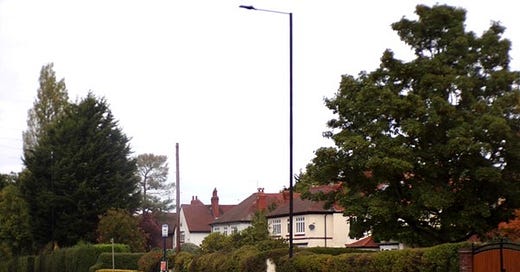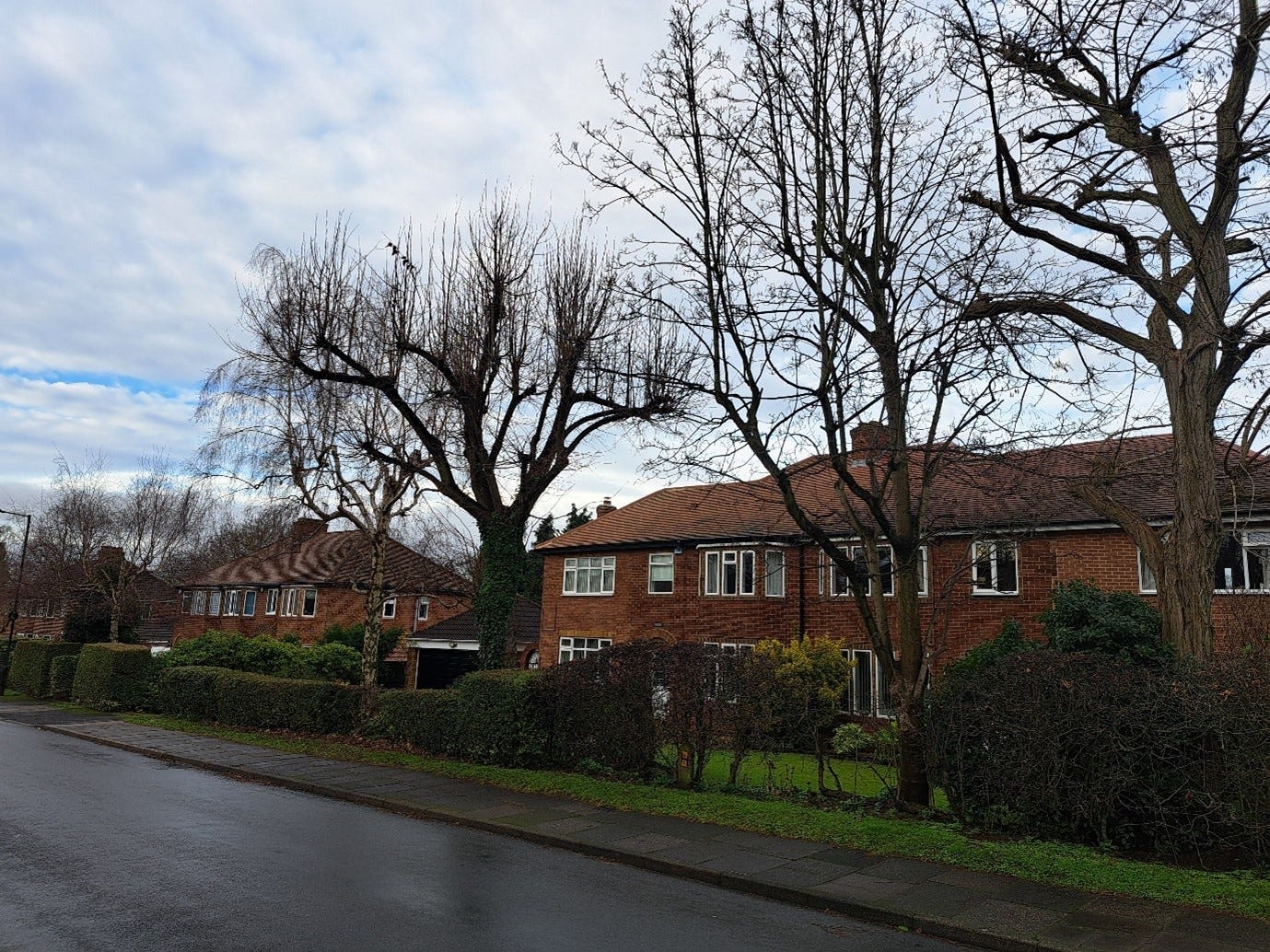[I have chosen to base the answer on the area where I live – Bessacarr, Doncaster. It is an unremarkable suburban area, similar to where I suspect many other people live. Yet, students are required to write about such areas (see the recent specification update from the exam board Pearson (Edexcel) below). I hope the answer gives some guidance as to what you could write about for your chosen ‘local’ place. Please note my self-imposed word limit of 600 words.]
Pearson (Edexcel) Specification Update.
[Author’s note: The same rules apply to other exam boards]
‘We’ve clarified that both the local and contrasting place should be a locality, a neighbourhood or a small community, either urban or rural.’
A reminder: for A level Geography, there are two key Assessment Objectives (AOs):
AO1: demonstrate knowledge and understanding of places, environments, concepts, processes, interactions, and change, at a variety of scales.
AO2: apply knowledge and understanding in different contexts to interpret, analyse, and evaluate geographical information and issues.
So, as on previous occasions, here are two versions of the answer.
The first answer is unannotated.
The second answer is in two formats:
(a) AO1 in italics
(b) AO2 in bold.
Assess the role of endogenous factors in shaping people’s lived experience in your local place or the distant place that you have studied.
The lived experience of people refers to how their lives have been influenced directly by living in that place or by visiting in person. That influence could be to their home, their work, their leisure or how they go about their lives. Endogenous factors are those that originate from within. They include natural characteristics, such as geology, altitude, slope angle, and demographic - the number of inhabitants, their ages, genders and ethnicities and their socio-economic and cultural characteristics. They also refer to the built environment - the ages/styles of buildings and housing types. I shall discuss the role of these factors in the context my local place: Bessacarr, Doncaster.
One of the key factors is the name of the place. The suffix ‘carr’ has roots in Norse and Old English, and it typically refers to marshy or wetland areas. Much of Bessacarr is low-lying, with water draining eventually into the River Idle, that feeds the Trent. The lower parts of the area are under medium flood risk, with large lakes at Potteric Carr, a nature reserve, a place popular with residents for leisure.
The higher parts of Bessacarr form a ridge which was used by the Romans as a route between Lincoln and York – known as Ermine Street. Today the road is known as Bawtry Road (part of the former A1) – a busy commuter road which often has heavy traffic slowing down journeys to and from work.
Bessacarr is a suburb with a population of 20,000 people. There is a significant proportion of families and older residents. It is more ethnically diverse than the UK average, with 65% of residents identifying as White. Approximately 87% of the population was born in the UK – 13% born outside the UK. There is quite a high proportion of people of Indian/Pakistani origin, many of whom work in the medical professions in the town. This reflects the fact that the largest employment sector, other than retired, is professional occupations, with a relatively high proportion of managers, directors and other officials.
Hence, Bessacarr is an affluent area, which generally has a low crime rate, and few incidents of anti-social behaviour. The local primary schools are popular and in high demand for places. However, there are few play areas for young children, and only one park, Haslam Park, for ball games. In terms of health, 46% of residents describe their health as very good, which is slightly lower than the national average.
Bessacarr offers a variety of housing types to suit different needs and income levels. The bulk of the housing is owner-occupied, consisting mostly of detached and semi-detached housing. Some of the lower and flatter parts of the area have high proportions of bungalows – an indicator perhaps of the proportion of retired people living there. There are some areas of Housing Association housing – consisting of newer forms of terraced housing and small apartments. These areas are well-integrated amongst the more affluent areas. Overall, Bessacarr is a desirable place to live, and estate agents generally have little difficulty in selling properties.
There are few places of employment in Bessacarr – two primary schools and a small shopping area, Nostell Place. Hence, nearly everyone leaves the area to go to work, though since the Covid pandemic, many people now work from home.
In conclusion, the lived experience of Bessacarr residents reflects strongly its endogenous factors. It is a large, but quiet, established, residential area largely made up of retired or professional people who desire to live in a safe and secure suburban environment. The area has some local history and its own special characteristics. (596)
Assess the role of endogenous factors in shaping people’s lived experience in your local place or the distant place that you have studied.
The lived experience of people refers to how their lives have been influenced directly by living in that place or by visiting in person. That influence could be to their home, their work, their leisure or how they go about their lives. Endogenous factors are those that originate from within. They include natural characteristics, such as geology, altitude, slope angle, and demographic - the number of inhabitants, their ages, genders and ethnicities and their socio-economic and cultural characteristics. They also refer to the built environment - the ages/styles of buildings and housing types. I shall discuss the role of these factors in the context my local place: Bessacarr, Doncaster.
One of the key factors is the name of the place. The suffix ‘carr’ has roots in Norse and Old English, and it typically refers to marshy or wetland areas. Much of Bessacarr is low-lying, with water draining eventually into the River Idle, that feeds the Trent. The lower parts of the area are under medium flood risk, with large lakes at Potteric Carr, a nature reserve, a place popular with residents for leisure.
The higher parts of Bessacarr form a ridge which was used by the Romans as a route between Lincoln and York – known as Ermine Street. Today the road is known as Bawtry Road (part of the former A1) – a busy commuter road which often has heavy traffic slowing down journeys to and from work.
Bessacarr is a suburb with a population of 20,000 people. There is a significant proportion of families and older residents. It is more ethnically diverse than the UK average, with 65% of residents identifying as White. Approximately 87% of the population was born in the UK – 13% born outside the UK. There is quite a high proportion of people of Indian/Pakistani origin, many of whom work in the medical professions in the town. This reflects the fact that the largest employment sector, other than retired, is professional occupations, with a relatively high proportion of managers, directors and other officials.
Hence, Bessacarr is an affluent area, which generally has a low crime rate, and few incidents of anti-social behaviour. The local primary schools are popular and in high demand for places. However, there are few play areas for young children, and only one park, Haslam Park, for ball games. In terms of health, 46% of residents describe their health as very good, which is slightly lower than the national average.
Bessacarr offers a variety of housing types to suit different needs and income levels. The bulk of the housing is owner-occupied, consisting mostly of detached and semi-detached housing. Some of the lower and flatter parts of the area have high proportions of bungalows – an indicator perhaps of the proportion of retired people living there. There are some areas of Housing Association housing – consisting of newer forms of terraced housing and small apartments. These areas are well-integrated amongst the more affluent areas. Overall, Bessacarr is a desirable place to live, and estate agents generally have little difficulty in selling properties.
There are few places of employment in Bessacarr – two primary schools and a small shopping area, Nostell Place. Hence, nearly everyone leaves the area to go to work, though since the Covid pandemic, many people now work from home.
In conclusion, the lived experience of Bessacarr residents reflects strongly its endogenous factors. It is a large, but quiet, established, residential area largely made up of retired or professional people who desire to live in a safe and secure suburban environment. The area has some local history and its own special characteristics. (596)
Two views of Bessacarr
Summer
Winter
If you are new to this Substack, then you may find these previous posts useful. They give my guidelines to essay writing.
Essay writing – 1 - by David Redfern - A Level of Geography





